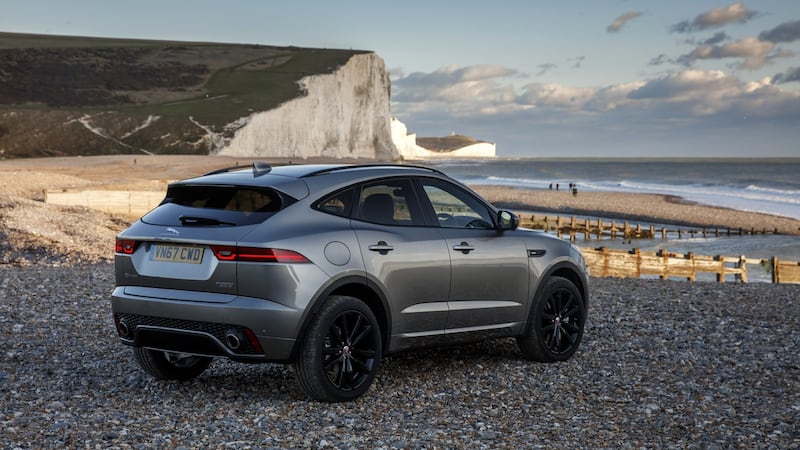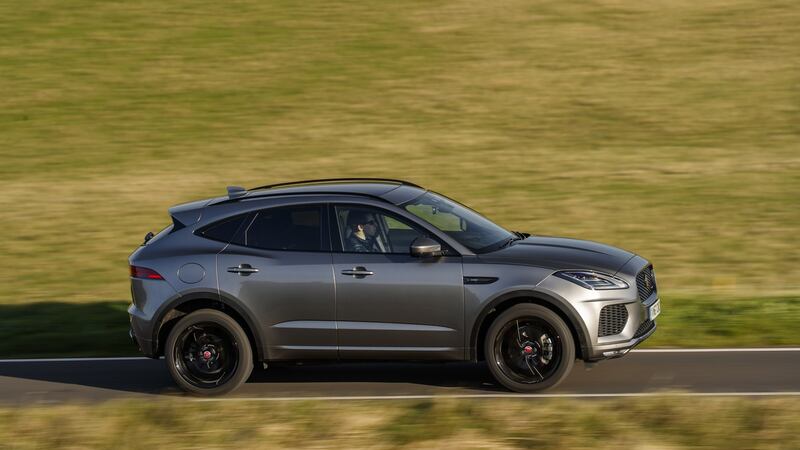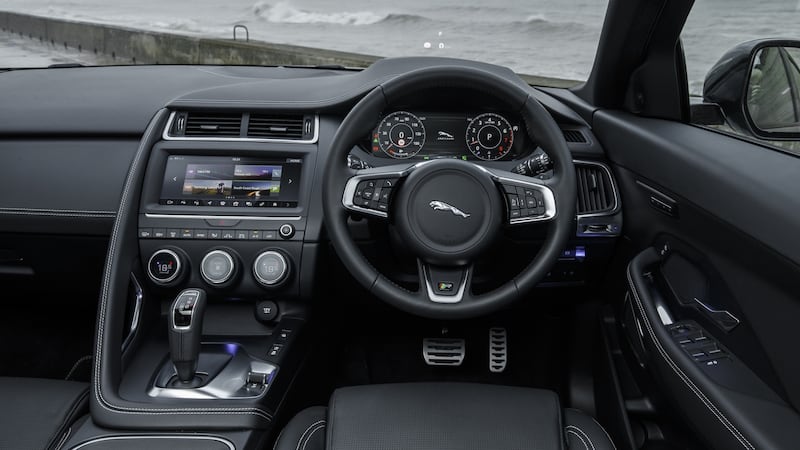The big cat has had a cub, thanks to some cross-breeding with its Land Rover cousins. Such incestuous cross-breeding can often lead to freakish abnormalities and character flaws, but first impressions of the new arrival suggest its temperament is sound.
Having witnessed the charge towards showrooms for the Range Rover Evoque, it was only a matter of time before the folks at its UK sibling tried their hand in the crossover market.
Following on from the roll-out of its F-Pace SUV, a smaller crossover was always on the cards. Enter the E-Pace. This is a booming market segment, after all. So-called premium compact SUVs are recording remarkable growth, globally and across Europe.
Up against the likes of the Audi Q3 and BMW X1, the five-seater E-Pace enters a segment that currently makes up 2 per cent of the overall new-car market in Europe. Forecasts suggest that's set to double by 2020. It's an increasingly competitive segment as well, with Volvo set to deliver its new XC40, chasing the same customer base, early in the New Year.
Chunky-looking
Less stylised than the Evoque, it's a chunky-looking, high-set hatchback. If there was a problem with the Evoque, it was that it has become something of a fashion statement, most popular with female buyers. The E-Pace, it is hoped by Jaguar, will prove a more unisex motor.
Based on a front-wheel drive transverse engine architecture, the E-Pace is essentially a beefed-up hatchback.
According to Jaguar's design guru, Ian Callum, it has the characteristics of a hot hatch. "I love this car, because I grew up in the hot hatchback days, when you were being offered small cars that you could really drive well. Now this is not a small car, but by our standards it is a small car and it really does have that hot hatchback feel about it. It's a lot of fun and this is my kind of car."
Callum is also proud of the fact his bosses at the firm opted for this more individual styling for E-Pace rather than just a diminutive duplicate of the firm’s F-Pace SUV.
There’s a plethora of design tricks to give the car more character than the rest of its rivals. A raked rear window and large, overhanging spoiler help, as does the distinctive lip in the middle of the rear, that takes some styling cues from Jaguar’s F-Type sports car.

Given its squat dimensions, the E-Pace is very sensitive to colour choices, and while it works well in gunmetal grey, it ideally needs a brighter colour to show off the contours. In black, for example, it looks more like a crossover from one of the mainstream Asian brands. Indeed, chatting with passersby wandering along Brighton promenade when the E-Pace test cars were parked up proved the point. One couple struggled to believe the E-Pace was actually a Jaguar at all, while another thought it must be a re-badging exercise from some Korean firm. However, both couples were tempted by the practicality of the cars, ease of access and the large 577-litre boot. And both were owners of German premium saloons, but were considering making the move to crossovers next time.
Tidy package
On the road, the E-Pace might not be as raw and passionate as a hot hatch, but it’s certainly a tidy package and easy to manoeuvre. There’s a lovely, cosseted feel to the car from the driver’s seat.
Rear-seat legroom is ample for adults and the headroom is impressive, but there is a compromise to be made: the windows sweep up quite sharply towards the rear, so passengers back there do not have great visibility out the side windows. It can make the car seem a little claustrophobic in the back, but that’s overcome if you opt for the optional panoramic glass roof.
Several interior features are taken from the F-Pace, such as the grab handle for the passenger, but there's enough tech on board to keep millennials happy. However, Jaguar remains one of the few brands yet to do a deal with Apple for its CarPlay system, so that's still not a feature on its touchscreen systems.

Powered by the firm’s 4-cylinder engines in either 2-litre petrol or diesel formats, it’s offered in either two-wheel or four-wheel drive and with either six-speed manual or nine-speed automatic transmission. For the diesel variants the offering is either 150bhp, 180bhp or 240bhp, and for petrol either 250bhp or 300bhp.
During a test run around the scenic countryside of southern England, we got the chance to try out the 300bhp petrol and the 180bhp diesel versions. While the backlash against diesel continues apace, it's fair to say that most Irish buyers will opt for it over the petrol equivalents here, and that's the right move, because the diesel 180bhp offers a nice blend of performance and low-end torque. Frankly, the petrol didn't seem quite as "hot hatch" as expected, particularly given that there are supposedly 300 horses on the reins.
Understeer
While it naturally tends towards understeer in corners, the E-Pace comes with a variety of handling features, particularly with its all-wheel drive system. In normal conditions, the system intelligently distributes torque between the front and rear to maximise stability and handling, or fuel economy, where appropriate. On slippery surfaces the system can send almost all of the engine’s power to the rear if the front axle loses traction.
Step up to the Active Driveline all-wheel drive system and you get the added benefit of two electronically controlled wet-plate clutches at the rear axle to distribute the torque to either of the rear wheels, calculating the optimum distribution of power every 100 milliseconds. During regular driving at a steady speed, the system disengages the all-wheel drive, sending power only to the front axle. This improves fuel efficiency. However, when a change in driving conditions is detected it can re-engage all-wheel drive within just 300 milliseconds.

One of the star turns for anyone considering doing anything rough and tumble in the E-Pace is the option of the impressive All Surface Progress Control system – effectively cruise control for off-roading. We first tried this system on the new Land Rover Discovery. Basically, the car takes over acceleration and braking in the trickiest conditions, leaving the driver to simply steer. Changes of surface sometimes see the car come to a halt as it works out how best to tackle the changing terrain, but within seconds it’s on the move again. On icy or snow-covered roads and driveways, it’s likely to prove a godsend for owners.
Major hurdles
At a time when car firms are seeking to reinvent themselves as tech firms, and with millennials more interested in their mobile phones than their motoring needs, Jaguar faces some major hurdles ahead. Its current selling points of dynamic driving and a luxury heritage will work for another few decades. However, with the advent of autonomous driving as a feature in cars – even on limited selected routes – consumer fears about handing over control to the car will push buyers to look to brands with strong reputations for reliable technology and safety. Safety is not an issue, but reliable technology has not been a trait for which either Britain or its car industry has built up a strong reputation. There’s a big job ahead.
For now the E-Pace seems a dead cert to dramatically boost sales, riding on the sales wave of crossovers. It’s a premium car with more character than its German rivals, a nice contrast to the arguably over-styled Evoque – or the Lexus NX for that matter – and the functional but forgettable offerings from Audi, BMW and the like.
The E-Pace pricing is good as well. As part of the initial launch, a two-wheel drive manual diesel version will be offered at €36,000 (courtesy of a €2,000 launch discount), making it remarkably tempting for many mainstream buyers. What’s certain is that it will introduce a raft of new customers to the brand, further expanding its fleet and further demonstrating the future of a brand that in previous decades was too wedded to its past. Certainly, the E-Pace is not the runt of Jaguar’s litter.
Lowdown: Jaguar E-Pace
Engine: Four-cylinder in either diesel (150bhp, 180bhp or 240bhp) or petrol (250bhp or 300bhp) with either front-wheel or all-wheel drive and six-speed manual or nine-speed transmission
CO2 (motor tax): 124g/km (€270) for 150bhp FWD diesel
0-100km/h: 6.4 seconds for 150bhp FWD diesel
Prices: From €38,000 (€36,000 for the limited edition launch price for 2-litre 150bhp manual E-Pace)











